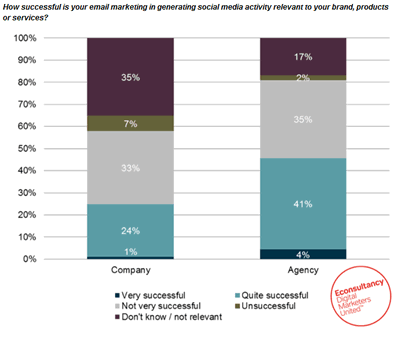Econsultancy’s Email Marketing Industry Census 2012 report shows email is still seen as a channel with a good return, with 70% of company respondents (thus, no agencies) saying ROI of email marketing is ‘excellent’ or ‘good’.
Email marketing ranks second after SEO, when it concerns reported ROI and this shouldn’t come as a surprise, just as it shouldn’t be a surprise that marketers keeps sending a lot of email.
2011 was the year when marketing experts saw that their “email is dead” messages were naïve. Email is far from dead. I can’t even start to count how many times I said this since social media became “hot”.
Email marketing still is essential
Will email die one day? I don’t know, and I don’t care. All I know is that, today (and tomorrow) email will remain a crucial part of the marketing mix of most businesses. It works, people still love it (if it’s well done), and it is part of every integrated marketing approach.
Let me give you an example. Although many people like to say the success of HubSpot, almost the ‘inventors’ of the term inbound marketing, is due to its inbound marketing strategy, the company owes a lot to email marketing. HubSpot will not ignore that, on the contrary: email is an essential ingredient of its solution.
It’s not a coincidence you need to take an email marketing class when you want to become a certified inbound marketing practitioner. I’m not saying that blogging, content marketing and other inbound tactics haven’t made HubSpot what it is. I’m saying it’s wrong to have a black-and-white vision about it, heralding just the power of content, social and blogging as some seem to do.
Integration and ROI
Even when used as a more ‘stand-alone’ channel, email is still pretty effective. However, using channels and tactics in an isolated way is not the best idea if you want to look at your customer and prospect as the complex and multichannel or channel-agnostic human being he is.
I guess Econsultancy’s findings that best practices such as segmentation and testing, in contrast to a simple ‘blast’ approach, are pretty obvious in that regard. However, most of all, the fact that 48% of respondents whose CRM and customer data are properly integrated with their email marketing, are more likely to consider the ROI of email good or excellent, is very significant, yet, again, obvious.
It’s not the integration as such that has a positive result on ROI. It’s the fact that a business which integrates its channels such as email with customer data, analytics, other business functions and other marketing tactics, is able to have a more customer-centric and integrated touchpoint marketing approach, that matters.
Customer-centricity: still a long way to go
Now, why does the title of this post read “Email Marketing: The Customer-Centric Culture Failure”?
Just look back at the findings I mentioned, until now, from that perspective of customer-centricity.
- Testing results in better ROI. Of course, it does. Testing and optimizing are not only about technical tips and tricks. It’s about analyzing what recipients want and offering it to them. In the end, it’s about understanding your customers.
- Segmentation works. Sure it does: when you segment – and personalize – you can improve your ‘messages’ depending on whom you’re interacting with.
- Integration with CRM and customer data improves ROI. That’s a no-brainer, isn’t it?
There also still is a huge gap between what improves the ROI of the channel and the degree in which these findings are turned into action. Although there are businesses that are “discovering” email marketing in a way, we can hardly call it a new marketing tactic.
Email marketers know very well what works. The key issue is one of customer-centricity and technology, that stands in the way of integration. I’m not even talking about the integration with channels such as social media here. I’m simply talking about integration of data and touchpoints.

The barriers to email integration
What are the main reasons why an amazingly high number of businesses can’t integrate email with CRM data, web analytics, other channels sales and conversion data (!) and even mobile(!)?
- On number one: disconnected systems and technologies with 46%.
- Next (a tie): lack of skills and training (15%) and organizational culture (also 15%).
Let’s look more in detail at this.
Why do so many businesses have disconnected systems and technologies? Historical – technological and other –reasons? That certainly is part of the issues. However, aren’t our systems as disconnected as the ways we look at our customers? Isn’t it a reflection of how we operate in silos? Think about it.
A lack of skills and training. Organizational culture. Aren’t these signs that a customer-centric view is missing? A customer-centric culture?
I don’t want to debate whether customer-centricity is about culture. However, it’s clear that the lack of skills and know-how concerns the customer, which a recipient is. Only 31% of companies regularly test their email marketing campaigns, which means most ones don’t seem to bother whether their emails are appreciated. Only 28% send out emails triggered by a site visit or sign-up and only 31% have welcome programmes, which means few businesses follow up their customer interactions.
A lack of optimization, testing, segmentation and the barrier of organizational culture for integration, all point in the same direction.
Correct me if I’m wrong. The good news? There is still a lot of room for improvement…

